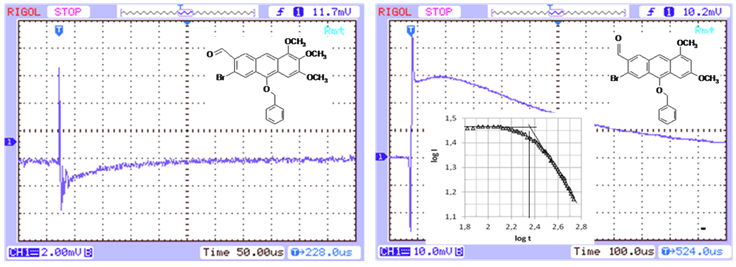Understanding of the charge transport process in the thin layers of hydrocarbons is challenging technological problem. In the last decade polymeric materials have shown a great application potential especially in development of optoelectonic elements, such as organic field effect transistors (OFETs)or organic light emitting diodes (OLEDs), organic photovoltaics (OPVs), But equivalently oligomeric and low molecular policyclic aromatic molecules posses a great potential for aplications due to possibility to create stacking systems of π-conjugated bonds what is an origin for obtaining high quality materials[1,2]. Obtaining the reproducible material parameters is facilitate due to strong covalent bonds in the molecule as a whole, and the possibility to control the microscopic structure and mean distance between molecules by a technological regime of preparation of the layer. Helpful is possibility to obtain high purity grade layers without residual traces of solvent.
Anthracene and its derivatives are especially attractive due to high termal stability, low price and good photolumenscent and electroluminescent properties.
Vacuum evaporation was used to deposit layers of O-benzyl protected diarylometanols, 10-(benzyloksy)-3-bromo--6,8-dimetoxyanthracene-2-karbaldehyde (mANTRADM) and 10-(benzyloksy)-3-bromo--6,7,8-trimetoxyanthracene-2-karbaldehyde (mANTRA). These materials were obtained involving Friedel-Crafts intramolecular cyclization [3, 4]
The measuring cells were prepared by vacuum thermal depositionon glass supplied with gold electrode, and then the by vaporization of semitransparent aluminium electrode. Such a a measuring cell has properties of plate capacitor with the layer of dielectric. For such layers the capacitance was measured with Semi-Automatic RLC Bridge type E314. The width of the layers was evaluated from the capacitance and geometric dimensions of electrodes. Measured layers had the width in the scope of 1 – 14 µm. Electrical characterization was made in two stage, first stage:verification the voltage of filling traps from the characteristics points of U-I characteristics and in the second stage: I-t transients were checked. Measurements of the transient currents were made with the set - up described in detail in [5,6]. Test apparatus was consisted of measuring cell in the Faraday Cage supplied with a quartz window, noiseless direct current supplier, fast ORIEL UV flash lamp: τ=1,6 µs, or fast high-pressure Werre - Quartz halogen lamp type VQX 107: τ=5µs, and computer with interface and monitor. Typicall oscillograph records are presented in Fig 1. for both measured materials. Time response of the electrical system was trasnsformed into double logarithmic scale, and the transit time (ttr) was obtained as a intersection point of the slopes according to the Scher-Montroll model [7] (see insert in the Fig.1b). Absence of the clear dependence τr on the voltage (Fig.2) approved the assumption, that the measured characteristic time is a life time of the current carriers [6,7]. The results are presented in the Table1. Making use of Einstein dependence, and approximation that the life time can be considered as volume life time [9] the evaluated mean electron mobility were: for mANTRA: 1∙10‑1 cm2/Vs, and for mANTRADM : 0,6∙10-1 cm2/Vs, and the mean hole mobility were: for mANTRA: 5,8∙10‑2 cm2/Vs,and for mANTRADM : 2.5∙10-2 cm2/Vs.
Table1. Charge life time for mANTRA and mANTRADM layers.
|
material |
electron life time [µs] |
hole life time [µs] |
|
mANTRA |
(0,05±0,2)·103 |
(0,32±0,07)·103 |
|
mANTRADM |
(0,14±0,05)·103 |
(0,36±0,03)·103 |

Fig. 1 Time of flight current: a). mANTRA (U=30V, L=6µm)), b) mANTRADM (U=150V, L=8,3µm), insert shows a log -log plot of transient current. The transit time(ttr) is defined as indicated in the figure

Fig.2 Inverse transit time as a function of applied bias for mANTRA (L=6 µm) and mANTRADM (L=8,3 µm).
References
- Di C., Zhang F., and Zhu D.; Adv. Mater. 25, 313-330,(2013)
- Zhong C., , Huang F., Cao Y., Moses D., and Heeger A. J., Adv. Mater. 26, 2341-2345,.( 2014)
- Bodzioch A., Marciniak B., Różycka-Sokołowska E., Jeszka J. K., Uznański P., Kania S., Kuliński J., Bałczewski P., Chem.Eur. J, 18, 4866-4877, (2012),.
- Bałczewski P., Bodzioch A., Skalik J., CHEMIK, 66, 1, 11-20, (2012).
- Kania S., Kuliński J., Chem. Met. Alloys, 4, 31-37(2011).
- Kania S., Kondrasiuk J., Bąk G.,W., Eur. Phys. J. E., 15. 439-442, (2004).
- Scher H., Montroll E., W., Phys. Rev . B, 12, (6), 2455-2477 (1975).
- H Fritsche, Proc. Int. Summer School on Semiconductors, ESPOO, Helsinki, , p. 2. 1982.
- Kania S., Dłużniewski M., Diamond & Related Materials, 14, 74-77(2005).





